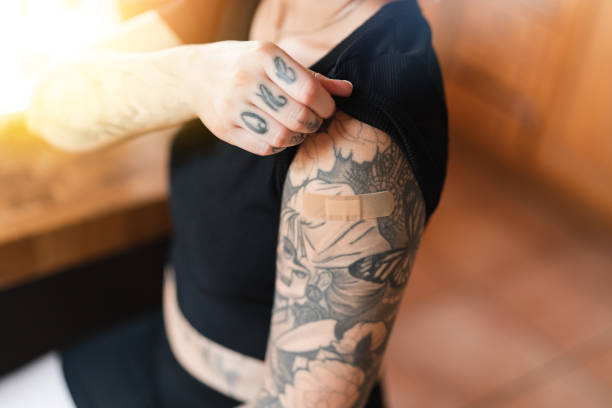Introduction
Tattoos are not just intricate pieces of art; they are also expressions of personal identity and creativity. However, the beauty of a freshly-inked tattoo is only the beginning of the journey. The tattoo healing process is a crucial stage that requires patience, proper care, and attention to detail. Understanding the intricacies of this healing journey is essential for ensuring the longevity and vibrancy of your new tattoo.
The Initial Stage: Post-Tattoo Care
The first hours after getting a tattoo are crucial for its healing process. Immediately after leaving the tattoo studio, the artist will cover the fresh tattoo with a sterile bandage or plastic wrap to protect it from external contaminants. This initial covering serves as a barrier against bacteria and prevents friction on the tattooed area.
It’s important to follow the artist’s instructions for removing the initial covering, typically within a few hours. Gently clean the tattooed area with mild, fragrance-free soap and lukewarm water. Pat the tattoo dry with a clean paper towel—avoid rubbing, as it may irritate the sensitive skin.
The First Few Days: The Scabbing and Peeling Stage
In the days following the tattoo application, the skin will start to form a protective scab. This scab is a natural part of the healing process, and while it may be tempting to pick at it, doing so can lead to complications, such as scarring and color loss. Let the scab naturally slough off as the skin underneath heals.
During this stage, it’s crucial to keep the tattoo moisturized using a recommended tattoo aftercare ointment. This helps prevent excessive drying and promotes optimal healing. Avoid exposing the tattoo to direct sunlight, as UV rays can fade the colors and damage the healing skin.
The First Weeks: Redness and Itching
As the scabbing stage subsides, the tattooed area may appear slightly red or irritated. This is a normal part of the healing process as the skin continues to regenerate. Itching is also common at this stage, but resist the urge to scratch, as it can disrupt the healing process and introduce bacteria to the area.
Continue applying the prescribed aftercare ointment and maintain good hygiene practices. Loose, breathable clothing is recommended to prevent unnecessary friction on the healing tattoo.
Weeks Two to Four: Settling into the Skin
During the second to fourth weeks, the tattoo should gradually settle into the skin. The redness and itching will subside, and the colors of the tattoo may appear more vibrant as the skin heals. However, the healing process is not yet complete, and it’s crucial to remain vigilant in your aftercare routine.
Continue moisturizing the tattoo, though the frequency may decrease. It’s also advisable to avoid swimming in pools or hot tubs during this period to prevent exposure to chlorine or other chemicals that may irritate the healing skin.
Months One to Three: Final Stages of Healing
As the first month transitions into the second and third, the tattoo will likely be mostly healed. However, the skin may still be undergoing subtle changes, and the complete healing process may extend to three months or more.
It’s essential to remain mindful of the tattoo’s exposure to the sun during this time. Applying sunscreen with a high SPF to the healed tattoo will protect it from harmful UV rays and maintain the longevity of the colors.
Long-Term Care: Preserving Your Investment
While the initial healing process is crucial, maintaining the appearance of your tattoo over the long term requires ongoing care. Keep your tattoo moisturized with a mild, fragrance-free lotion, and continue to protect it from excessive sun exposure.
Regularly check your tattoo for any signs of irritation, infection, or color fading. If you notice any abnormalities, consult with a dermatologist or your tattoo artist promptly.
Conclusion
The journey of tattoo healing is as intricate as the art itself. From the initial post-tattoo care to the long-term preservation of your investment, understanding each stage is vital for ensuring a vibrant, lasting tattoo. Patience, diligence, and proper aftercare are the keys to a successful healing process, allowing you to proudly showcase your unique piece of art for years to come.

